PNG Flag and National Anthem
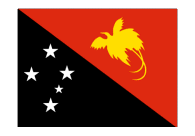 The
Papua New Guinea National flag, formally adopted
in 1971, is rectangular in proportion of four
to three. It is divided diagonally from the
top to the hoist to the bottom of the fly.
On the upper part appears a yellow "
Kumul ", Bird of Paradise on the red
background. On the yellow part are five stars
representing the Southern Cross, on the black
background. Black, red and yellow are traditional
colors in Papua New Guinea. The
Papua New Guinea National flag, formally adopted
in 1971, is rectangular in proportion of four
to three. It is divided diagonally from the
top to the hoist to the bottom of the fly.
On the upper part appears a yellow "
Kumul ", Bird of Paradise on the red
background. On the yellow part are five stars
representing the Southern Cross, on the black
background. Black, red and yellow are traditional
colors in Papua New Guinea.
The Bird of Paradise plays and important role
in the social and
cultural activities of many groups in the
country and its plumes are often used as ceremonial
decoration. On the flag it is shown soaring
above the Southern Cross, with display plumes
trailing, symbolizing Papua New Guinea's emergence
into nationhood.
The Southern Cross is the constellation notable
in the night skies of
Papua New Guinea and other countries of the
Southern Hemisphere.
It appears on the flag to signify the country's
historical relationship
with other nations of the South Pacific.
National Anthem: " O ARISE
ALL YOU SONS "
VERSE 1 O arise all you sons of this land
Let us sing of our joy to be free.
Praising God and rejoicing to be
Papua New Guinea.
CHORUS Shout our name from the mountain
to seas
Papua New Guinea.
Let us raise our voices and proclaim
Papua New Guinea.
VERSE 2 Now give thanks to the good Lord
above
For His kindness, His wisdom and love
For this land of our fathers so free,
Papua New Guinea.
CHORUS Shout again for the whole world
to hear
Papua New Guinea,
We're independent and we're free,
Papua New Guinea.
PNG Crest
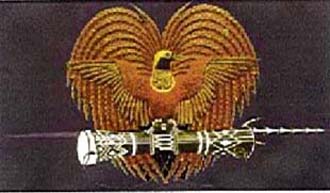
The National Parliament Building
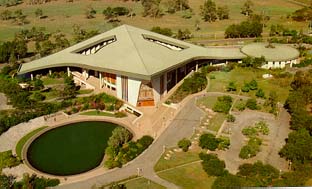
"A majestic and monumental building
that captivates; the visions of our ancestors,
the legacies of our past; the beauty, spirit
and diversity of our people and our culture;
and passionately promulgates the hopes,
dreams and future of our new generation.
And in modern parlance of democratic governance;
it projects our own brand of parliamentary
democracy under the Westminster model of
Government. A brand of parliamentary democracy
that is still evolving and whose ultimate
shape, form, ebullient spirit and substance
will be determined at our own time, pace,
and tempo; and sets forth our destiny as
an emerging independent sovereign nation
state."
Sir Nagora Bogan, KBE
April, 1999
This monumental building when viewed from
the air looks like a great bird nestled
on the gentle slopes of Waigani, just within
the metropolis of Port Moresby, the capital
city of Papua New Guinea. Rising above the
main entrance to the chamber is a peaked
roof modeled on the haus tambaran, the men's
spirit haus of the Sepik region in the North
Western part of Papua New Guinea. The roof
sweeps down over a central office building
to end in a roundhouse whose form comes
directly from the traditional roundhouses
in many regions of the highlands of Papua
New Guinea.
The Democratic Assertion of the
People
Perched within the arch of the peaked roof
is a resounding assertion that underscores
and extols the virtues of Papua New Guinea's
own inventive intonation of one of the most
fundamental tenets of democracy.......
The interior and the decorative elements
are equally eclectic. Door handles are shaped
like kundu drums (i.e. local drum commonly
used in traditional dances). The ceiling
above the main hall is decorated with local
tapa designs.
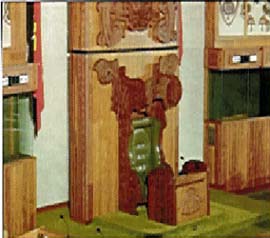
The Speakers chair is surrounded by intricate
carvings originating from the ceremonial
canoes from the Trobriand Islands and some
regions of the Miln Bay province. The chair
itself is Westminster, but the whole effect
is more reminiscent of the orator's stool
which features in many villages ceremonies
throughout Papua New Guinea. And carved
into the base is a garamut, a long cylindrical
drum from Manus Island used to call people
together.
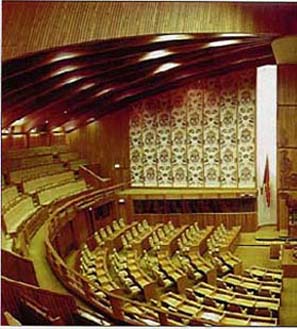
The floor of the chamber is arranged as
a sweeping semi-circle aroud the speaker
with elegant traditional décor. Each
of the 109 Members of Parliament has a large
desk and ear phones on which he can hear
proceedings translated into English, and
the two prominent local vernaculars of -
Police Motu and Tok Pisin. The Chamber also
incorporates advisors booth for the members
advisors, and press gallery for the press
corps. The public gallery can accommodate
up to 600 audiences. Practically, all Parliamentary
sessions are open to the public and in recent
years some important sessions have been
televised on the local television station,
EMTV.
|